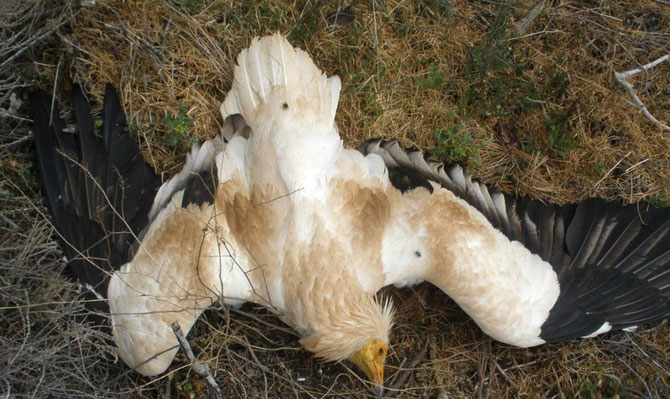
A total of 21.260 animals were poisoned in 9700 different poisoning incidents between 1992 to 2017 according to the latest Report on wildlife poisoning in Spain. Overall, this Report indicates that illegal wildlife poisoning seems to be decreasing in Spain following the vast work and investment done over the years to reduce this harmful practice.
SEO/BirdLife and WWF Spain have published this newly updated Report in collaboration with BirdLife Europe and with funding by the MAVA Foundation. The following article summarizes the key findings of the Report with a focus on the effects on the vulture populations in Spain.
Most commonly used poison baits in Spain
The most widely used poison in Spain is carbamate aldicarb, a substance banned since 2007, and which appears in 40% of recorded episodes, followed by carbofuran (24% of cases), banned since 2008, and strychnine (5%), banned since 1994.
Impact of poisoning on wildlife in Spain
Illegal wildlife poisoning poses a severe threat to wildlife, vultures and also public health. In most cases, hunters and livestock breeders use poison baits to intentionally kill predators considered harmful to game species or livestock, which often ends up affecting other species that were not intended to be killed.
Wildlife poisoning is illegal and is considered a wildlife crime under Spanish law. Despite this, in Spain, a total of 21,260 dead animals have been collected and analyzed, confirming that they had consumed poisoned baits, from 9,700 poisoning incidents, between 1992 and 2017. These numbers, however, don’t represent the real dimension of the damage, since only a small part of poisoning cases are detected.
The illegal use of poison baits severely harms Spanish biodiversity, affecting threatened species like the Egyptian and Cinereous Vultures alongside other bird species and mammals including the Brown bear, Iberian wolf and Iberian lynx or fox. This issue also affects many pets in urban settings, although this Report only covers cases of poisoning in the wild.
Impact of poisoning on vultures in Spain
Illegal wildlife poisoning is considered vultures’ biggest threat on a global level and severely affected by this practice in Spain. The Griffon Vulture is the most poisoned bird of prey in Spain, with 1,757 individuals falling victim to this damaging practice, corresponding to 23.4% of all raptor species affected. The other vulture species present in Spain are also greatly affected, especially the Cinereous and Egyptian Vultures. A total of 624 Cinereous Vultures (8.31%) were poisoned, 325 Egyptian Vultures (4.32%) and 48 Bearded Vultures (0.64%) between the period analysed in the Report.
However, to assess the effect of poisoning on the conservation of each species, the Report takes into account the number of individuals affected, as well as other factors such as the population size of the species. The findings suggest that poisoning causes more adverse effects on the populations of the Cinereous Vulture, Egyptian Vulture and Bearded Vulture than the one of the Griffon Vulture, even though it has the most affected individuals.
Evolution of poisoning and vultures in Spain
Wildlife poisoning has caused the decline of many vulture populations in Spain, Europe and beyond. Even though many vulture populations declined in the country over the 20th century due to illegal wildlife poisoning, they are now making a comeback, and today, Spain is the stronghold for vultures in Europe. Spain is setting the standard when it comes to tackling poisoning, with Andalusia, in particular, being the model for training and capacity building elsewhere.

To give some perspective on the great work done in Spain, the Cinereous Vulture population has grown from 200 pairs in 1973 to 2,548-3,140 pairs according to the 2017 census coordinated by SEO/BirdLife. Poison is the first cause of unnatural mortality for this species, but there is progress. When comparing the two periods of thirteen years (1992-2004 and 2005-2017) in the Report, a significant decrease is evident in the number of poisonings found in the second period, from 366 to 258. Andalusia again played a key factor in this decrease.
You can access the full Report on wildlife poisoning in Spain between 1992-2017 (in Spanish) here.
How we tackle illegal wildlife poisoning — vultures’ biggest threat
The Vulture Multi-species Action Plan (Vulture MsAP), co-developed by us here at the Vulture Conservation Foundation (VCF), and endorsed by the Convention for Migratory Species (CMS), concludes that the use of poison bauts us the biggest threat to vultures worldwide and a significant part of this global action plan for vultures focuses on the actions needed to fight this threat.
We here at the VCF are actively pursuing different lines of work to fight vultures’ biggest threat. We are implementing many projects and actions to do so, and are involved in programmes across Europe where we also facilitate training in Spain. One of the projects we lead is the Balkan Anti-Poisoning Project (BAPP), funded by the MAVA Foundation. The BAPP is a cross-border initiative bringing together wildlife conservation organizations, governmental agencies and other stakeholders such as; hunting associations, farmers and scientists, in six Balkan countries to tackle illegal wildlife poisoning.

Sign up to our newsletter to stay informed on how we protect vultures together with our partners!



